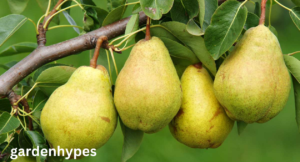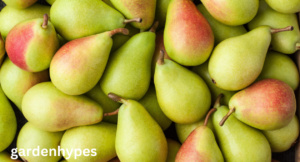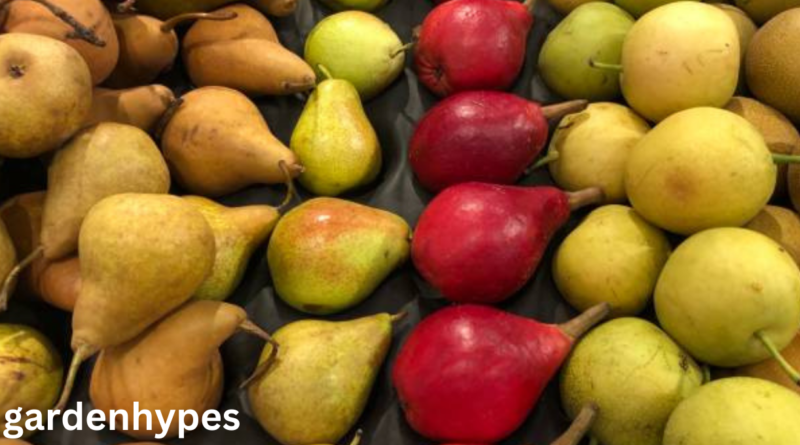Pear Varieties A Complete Guide to Types Taste and Uses
Introduction
Pear Varieties are one of those fruits that effortlessly bridge the gap between sweetness and subtle tartness. They’re juicy, versatile, and come in a range of textures—from buttery smooth to crisp and crunchy. What’s fascinating is how diverse pear varieties really are. You could bite into a Bartlett pear and be greeted with soft, melting sweetness, while an Asian pear will surprise you with its apple-like crunch and delicate flavor.
click in link Fruits That Look Like Guava
One of the biggest reasons pears remain a favorite across the globe is their adaptability. They fit into salads, desserts, savory dishes, or can be eaten raw right off the tree. Beyond taste, pears pack a solid nutritional punch. They’re rich in dietary fiber, particularly pectin, which helps with digestion and keeps you feeling fuller for longer. They’re also a natural source of vitamin C, potassium, and antioxidants—all of which support immunity, skin health, and heart function.
But here’s the best part: each pear variety has its own personality. Some shine when baked into pies or poached with spices, while others are perfect for fresh snacking. Understanding the differences between varieties can make your eating experience much more enjoyable.
In this guide, we’ll explore pear varieties in detail—from their history and origins to the most popular types available today. By the end, you’ll not only know the difference between a Bosc and a Comice, but also which one belongs in your fruit basket depending on the season and your taste preferences.
The History and Origin of Pears
Pears have been around for thousands of years, making them one of the oldest cultivated fruits. Their journey began in the foothills of Central Asia, with wild pear species growing naturally along ancient trade routes. From there, they spread across Europe and Asia, evolving into distinct varieties depending on climate and cultivation methods.
In Europe, pears became a staple during the Roman Empire. Historical texts describe how Romans experimented with grafting techniques to produce new pear varieties. Over time, European pears developed their signature soft, buttery flesh. These were different from the firmer, crisper varieties that evolved in Asia, where pears were prized for their refreshing juiciness.
By the 1600s, pears were being cultivated in North America, brought over by early settlers. They adapted well to the temperate climate, and today, the U.S. Pacific Northwest—especially Oregon and Washington—remains one of the largest pear-growing regions in the world.
What’s particularly interesting is how different cultures shaped pears into symbols of prosperity and health. In China, pears symbolize immortality, while in Europe, they were often gifted as tokens of affection. Today, the pear industry continues to evolve, with breeders working on varieties that can withstand climate change, resist pests, and provide longer shelf life without losing their natural sweetness.
The story of pears isn’t just about agriculture—it’s about how a fruit managed to weave itself into history, culture, and cuisine across the world.
Main Categories of Pears
While there are thousands of pear varieties grown globally, they mainly fall into three broad categories: European pears, Asian pears, and hybrids. Each category comes with its own set of characteristics, which influence not only taste but also how they are used in cooking and eating.
European Pears (Pyrus communis)
European pears are the most widely recognized in the Western world. They have that classic pear shape—round at the bottom with a tapering neck. Their flesh is soft, buttery, and often melts in your mouth when ripe. Popular varieties like Bartlett, Anjou, and Bosc belong here. These pears are perfect for eating fresh but also hold up well in cooking.
click in link Fruits That Look Like Guava

Asian Pears (Pyrus pyrifolia)
Asian pears are quite different. They’re often round like apples, with a crisp, juicy bite. Their skin can be golden, russeted, or light green. Unlike European pears, Asian pears are usually eaten crunchy rather than waiting for them to soften. Varieties like Nijisseiki and Hosui are prized in Asia and are increasingly popular worldwide.
Hybrid Pears
Hybrid pears are a cross between European and Asian varieties, developed to combine the best qualities of both. They may have the crunchiness of Asian pears with the sweetness of European ones. These hybrids are not as common in supermarkets but are gaining attention among growers for their resilience and unique flavors.
Knowing which category a pear belongs to makes it easier to choose the right one for your taste and cooking needs.
Popular European Pear Varieties
European pears dominate most grocery stores, especially in Western countries. They are beloved for their rich flavors and versatility. Here are the most notable ones:
Bartlett Pears (Williams Pears)
Bartlett pears, also known as Williams pears outside North America, are the most widely grown pear variety. They’re instantly recognizable for their classic pear shape and smooth, thin skin. Bartletts start out green but turn yellow as they ripen. They’re extremely juicy and sweet, making them excellent for eating fresh, canning, and juicing.
One interesting trait is how fragrant they are—their aroma often fills a room when fully ripe. However, Bartletts bruise easily, so they need gentle handling. Their soft flesh also makes them less ideal for baking but perfect for preserves and fresh desserts.
Anjou Pears (Green and Red)
Anjou pears are squat and egg-shaped, without the classic long neck. They come in two main colors: green and red. Green Anjou pears remain green even when ripe, while Red Anjous develop a beautiful crimson hue.
Their flavor is mild and subtly sweet, making them one of the most versatile pears. They’re firm enough for baking and roasting but juicy enough to enjoy raw. Their late-season availability also makes them a winter favorite.
Bosc Pears
Bosc pears stand out with their elongated necks and golden-brown, russeted skin. Their flesh is denser than most pears, with a honey-sweet flavor that intensifies when cooked. Because of their firm texture, Bosc pears hold their shape beautifully in baking, poaching, and roasting.
Unlike Bartletts, they’re less juicy but much more structured, making them a chef’s favorite for elegant desserts.
Comice Pears
Often called the “Christmas pear,” Comice pears are large, round, and exceptionally sweet. Their flesh is buttery, juicy, and delicate—perfect for eating raw. They pair beautifully with cheese, especially brie, which is why they’re often included in holiday gift baskets.
Their only downside is their fragility. Comice pears bruise easily, which makes them harder to ship and store compared to sturdier varieties like Anjou or Bosc.
Concorde Pears
Concorde pears are a cross between Comice and Conference pears. They’re long and elegant, with a smooth green skin. Their flavor is sweet and vanilla-like, with a texture that stays firm even when fully ripe.
This makes them excellent for both fresh eating and baking. They’re also slow to brown after being cut, which is a big plus for salads and garnishes.
Popular Asian Pear Varieties
Asian pears are gaining popularity in Western markets, and for good reason. Their crispness, juiciness, and refreshing flavors make them a standout choice.

Nijisseiki (20th Century Pears)
Nijisseiki pears, often called 20th Century pears, are round with a smooth, light-yellow skin. They’re incredibly juicy with a sweet yet mild flavor. Unlike European pears, they maintain a crunchy texture even when ripe.
They’re especially popular in Japan, where they’re often gifted as premium fruits.
Hosui Pears
Hosui pears are bronze-skinned with a hint of russeting. They have a balanced flavor—sweet, tart, and aromatic all at once. Their juicy crunch makes them excellent for snacking, but they also hold up well in salads and cold dishes.
click in link Fruits That Look Like Guava
Shinko Pears
Shinko pears are another crisp and refreshing variety. Their skin is golden-brown, and their flavor leans toward mild sweetness. They have a long shelf life, which makes them practical for both markets and home storage.
Ya Pears
Ya pears, also known as Chinese white pears, have a pale yellow to white skin. Their flavor is delicate and floral, with high water content. They’re often enjoyed chilled as a refreshing treat in hot climates.
faqs
- What is the sweetest pear variety?
The Comice pear is often considered the sweetest and juiciest of all pear varieties. Its soft, buttery flesh and honey-like flavor make it perfect for enjoying fresh. If you prefer crisp sweetness, Asian pear varieties like Hosui or Nijisseiki are also excellent choices. - Which pear variety is best for baking?
Bosc pears are the go-to choice for baking. Their firm texture holds up beautifully in pies, tarts, and poached desserts without turning mushy. Concorde pears also work well since they stay firm even when fully ripe. - How do you know when a pear is ripe?
The best way to check is to gently press near the stem. If it gives slightly, the pear is ripe and ready to eat. Keep in mind that some varieties, like Bartletts, ripen quickly after purchase, while Anjous and Bosc pears take longer to soften. - Are Asian pears healthier than European pears?
Both types of pears are healthy, but they differ slightly. Asian pears have fewer calories and are higher in water content, making them super refreshing. European pears, on the other hand, generally contain more dietary fiber, which supports digestion. - Which pear variety lasts the longest in storage?
Anjou pears and Shinko Asian pears are known for their excellent storage life. When kept in a cool, dry place—or better yet, refrigerated—they can last several weeks without losing flavor or texture.
